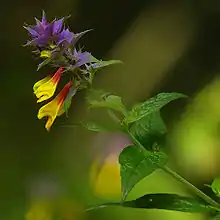Melampyrum nemorosum
Melampyrum nemorosum is an herbaceous flowering plant in the family Orobanchaceae. It is native to Europe. In Sweden it is called natt och dag. (Night and Day)[1] In Russia it is called Ivan-da-Marya. (Ivan and Maria) a Christianisation of the traditional Slavic Kupalo-da-Mavka (Kupalo-and-Mavka).
| Melampyrum nemorosum | |
|---|---|
 | |
| Scientific classification | |
| Kingdom: | Plantae |
| Clade: | Tracheophytes |
| Clade: | Angiosperms |
| Clade: | Eudicots |
| Clade: | Asterids |
| Order: | Lamiales |
| Family: | Orobanchaceae |
| Genus: | Melampyrum |
| Species: | M. nemorosum |
| Binomial name | |
| Melampyrum nemorosum | |
This is an annual plant. The new leaves are blue, turning green as they mature. They are usually toothed at the bases.
This plant is a host to the rust fungus Coleosporium melampyri [2] und Cronartium flaccidum with the associated uredium und telium.[3]
 Flower
Flower Flowers in yellow and red contrast the purple top leaves
Flowers in yellow and red contrast the purple top leaves
References
- Melampyrum nemorosum. Invasive Species Compendium. CABI.
- Peter Zwetko: Die Rostpilze Österreichs. Supplement und Wirt-Parasit-Verzeichnis zur 2. Auflage des Catalogus Florae Austriae, III. Teil, Heft 1, Uredinales. (PDF; 1,8 MB).
- Kaitera, J. and H. Nuorteva. (2003). Cronartium flaccidum produces uredinia and telia on Melampyrum nemorosum and on Finnish Vincetoxicum hirundinaria. Forest Pathology 33: 205–213. doi: 10.1046/j.1439-0329.2003.00321.x
This article is issued from Wikipedia. The text is licensed under Creative Commons - Attribution - Sharealike. Additional terms may apply for the media files.